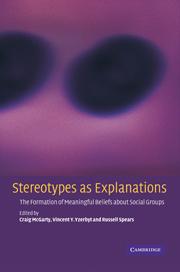Book contents
- Frontmatter
- Contents
- List of figures
- List of contributors
- Preface
- 1 Social, cultural and cognitive factors in stereotype formation
- 2 Stereotype formation as category formation
- 3 Subjective essentialism and the emergence of stereotypes
- 4 The role of theories in the formation of stereotype content
- 5 Illusory correlation and stereotype formation: making sense of group differences and cognitive biases
- 6 Dependence and the formation of stereotyped beliefs about groups: from interpersonal to intergroup perception
- 7 Four degrees of stereotype formation: differentiation by any means necessary
- 8 From personal pictures in the head to collective tools in the world: how shared stereotypes allow groups to represent and change social reality
- 9 Conclusion: stereotypes are selective, variable and contested explanations
- References
- Author index
- Subject index
7 - Four degrees of stereotype formation: differentiation by any means necessary
Published online by Cambridge University Press: 22 September 2009
- Frontmatter
- Contents
- List of figures
- List of contributors
- Preface
- 1 Social, cultural and cognitive factors in stereotype formation
- 2 Stereotype formation as category formation
- 3 Subjective essentialism and the emergence of stereotypes
- 4 The role of theories in the formation of stereotype content
- 5 Illusory correlation and stereotype formation: making sense of group differences and cognitive biases
- 6 Dependence and the formation of stereotyped beliefs about groups: from interpersonal to intergroup perception
- 7 Four degrees of stereotype formation: differentiation by any means necessary
- 8 From personal pictures in the head to collective tools in the world: how shared stereotypes allow groups to represent and change social reality
- 9 Conclusion: stereotypes are selective, variable and contested explanations
- References
- Author index
- Subject index
Summary
Introduction
Stereotype formation is a strangely neglected topic within social psychology. Research in the social cognition tradition tends to treat stereotypes as givens: cognitive heuristics, which are part of our mental repertoire (or cognitive toolbox), that are activated and then applied (e.g., Gilbert & Hixon, 1991). This two-step process already presumes the fact of formation. So, although this general approach has proved to be of considerable heuristic value, it is not clear that this tells us too much about how stereotypes are formed in the first place. This approach kicks in after the stereotypes are in place so to speak. There has also been some debate in recent years about whether stereotypes are constructs we can always take ‘off the peg’ in this pre-packaged way (see e.g., Spears & Haslam, 1997). In this chapter we have our cake and eat it: we accept that stereotypes sometimes represent well learned knowledge structures about social groups that are simply activated, but at other times they have to be constructed in context from the resources available. However, if we are to consider stereotype formation it is surely self-evident that we cannot rely exclusively on prior knowledge or fixed structures.
Arguably if we want to look at how stereotypes are formed, we have to consider more dynamic and social processes that govern the relations between groups: how meaning is extracted, constructed and developed over time.
- Type
- Chapter
- Information
- Stereotypes as ExplanationsThe Formation of Meaningful Beliefs about Social Groups, pp. 127 - 156Publisher: Cambridge University PressPrint publication year: 2002
- 9
- Cited by



